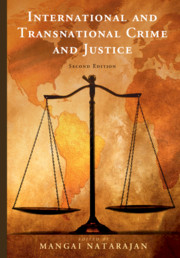Book contents
- International and Transnational Crime and Justice
- International and Transnational Crime and Justice
- Copyright page
- Contents
- Figures and Tables
- Preface
- About the Editor
- Notes on Contributors
- Introduction
- PART I OVERVIEW: TRANSNATIONAL CRIME
- PART II OVERVIEW: INTERNATIONAL CRIME
- PART III OVERVIEW: INTERNATIONAL AND TRANSNATIONAL CRIME RESEARCH
- World Map
- Index
- References
PART III - OVERVIEW: INTERNATIONAL AND TRANSNATIONAL CRIME RESEARCH
Published online by Cambridge University Press: 20 June 2019
- International and Transnational Crime and Justice
- International and Transnational Crime and Justice
- Copyright page
- Contents
- Figures and Tables
- Preface
- About the Editor
- Notes on Contributors
- Introduction
- PART I OVERVIEW: TRANSNATIONAL CRIME
- PART II OVERVIEW: INTERNATIONAL CRIME
- PART III OVERVIEW: INTERNATIONAL AND TRANSNATIONAL CRIME RESEARCH
- World Map
- Index
- References
- Type
- Chapter
- Information
- International and Transnational Crime and Justice , pp. 461 - 515Publisher: Cambridge University PressPrint publication year: 2019
References
REFERENCES
WEBSITES
Detailed tables containing data from the UCR for each year can be found at https://ucr.fbi.gov/crime-in-the-u.s.
Information about methodology and published reports using NCVS data are available at www.bjs.gov/index.cfm?ty=dcdetail&iid=245.
Original data files for the UCR, NCVS, Supplementary Homicide Reports, and the National Incident-Based Reporting System can be obtained from the National Archive of Criminal Justice Data at www.icpsr.umich.edu/NACJD/index.html.



